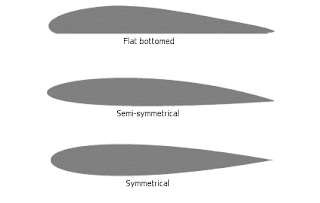In the last post, I mentioned briefly how a stall works but this time, I will explain it in a little more detail and also talk about some other concepts involving the stall.
AIRFOILS AND LIFT COEFFICIENT
Picture an RC airplane from above, the fuselage in the middle and the wings on the right and left side. Now, look at the plane from the side, ninety degrees to the right or left from the angle you just looked at it from. What you see now is called an airfoil and they come in many shapes and sizes.
The one on the top, flat bottomed airfoils, have a lift coefficient of about 1.0 at a normal angle of attack. The next one down, semi-symetrical airfoils, have a slightly lower lift coefficient of 0.8 to 0.9 at that same angle of attack. The bottom one, symmetrical airfoils, have a lift coefficient of 0.5 to 0.6. What's important is that higher lift coefficients decrease the stall speed of an RC plane and lower lift coefficients do the opposite to the stall speed. For example, an RC plane with a wingspan of 1 meter, weight of 986 grams and a wing area of 17.5 square decimetres with a lift coefficient of 1 will have a stall speed of 34 km/h. With a 0.8 lift coefficient, its stall speed will be 38 km/h. So, flat bottomed airfoils are generally better for lift and although symmetrical airfoils have a lower lift coefficient, they are much more suited to aerobatic planes that will need to fly inverted because there is an equal airfoil shape on both sides. Faster RC planes often have a straight wing with no airfoil. There are lots of tables on the NACA airfoil website that will show exactly what the lift and drag coefficients are of different airfoils at different angles of attack. When the trend of lift coefficient starts decreasing rapidly, that is the point that the airfoil has stalled. Angle of attack or A.O.A is the angle of a plane's airfoil to the ground.
WINGS STALL ON THE INSIDE FIRST
Wings for full-sized airplanes are always designed so that the inside of the wing (section closest to the fuselage) stalls before the tip of the wing (section farthest from the fuselage). If not, there would be no way of controlling the roll of the plane. RC planes are sometimes designed the same way.
WASHOUT
One of the ways of making sure that the tips stall after the inner part of the wing is called washout.
One form of washout is when the tips of the wings have a lower angle of incidence or angle of attack A.O.A than the inner part of the wings closest to the fuselage.


Hi Stefan I'm having a lot of trouble because my RC plane keeps crashing. It is a 4 tiered biplane with a thrust to weight ratio of 5 and really small wings. I bought some more wings and glued them onto the tail to make these really long wings instead of horizontal stabilizers, but they just dragged on the ground! Help? What should I do?
ReplyDeleteGet a life
ReplyDeleteHi Stefan I was at the flying field when someone called my plane "stupid" and broke it. This is a very sad moment for me. I know this plane is worth repairing but the fuselage is currently in three pieces. I am keeping a positive attitude however and am thinking of a (this is a great idea) THREE TIERED FUSELAGE! Thanks to your helpful posts about loading coefficients, stalls, and wings, I have decided to take pieces of a bathroom stall, saw 'em up, and also get some tinfoil from my kitchen to use as airfoils! This is going to be a great project! Hope to keep you updated!!!
ReplyDeletePlease don't
ReplyDelete